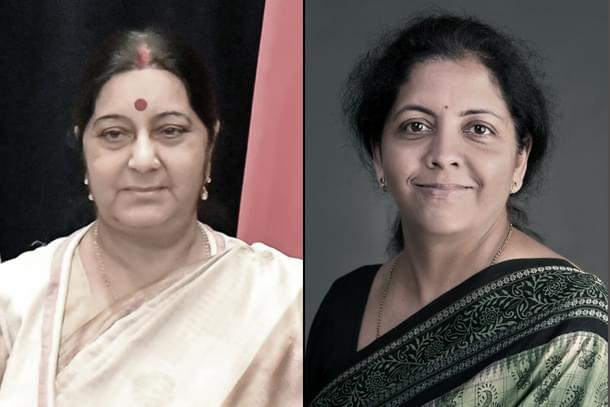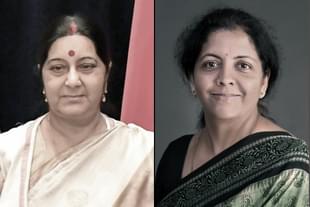World
Two-Plus-Two Dialogue: What India And US Will Strive For At This Key Meeting
M R Subramani
Sep 04, 2018, 04:52 PM | Updated 04:52 PM IST
Save & read from anywhere!
Bookmark stories for easy access on any device or the Swarajya app.


Two days from now, India’s two most prominent women in the Narendra Modi Cabinet will be seated across the table with US Secretary of State Mike Pompeo and US Defence Secretary Jim Mattis to find out ways of improving defence and diplomatic relations between both the countries. External Affairs Minister Sushma Swaraj and Defence Minister Nirmala Sitharaman will hold the inaugural “two-plus-two” dialogue with Pompeo and Mattis that the US has termed “a major opportunity” to improve ties between New Delhi and Washington.
The two-plus-two dialogue basically involves the Foreign and Defence ministries of two countries and it is a mechanism to hold regular dialogue, possibly every year, between political leaders.
A close look at the functioning and outcomes of the existing two-plus-two dialogue mechanism comprising ministries of Defence and Foreign Affairs suggest that this mechanism sets the agenda for a summit level interaction between the leaders of the two countries. The two-plus-two dialogue mechanism is between countries which have institutionalised annual dialogue or at least a regular dialogue between the political heads of the two states. India holds a similar dialogue with Japan.
The intention to hold the dialogue with the US was announced after Prime Minister Narendra Modi’s meeting with US President Donald Trump last year. The dialogue has been postponed at least twice but is now all set to be held on 6 September (Thursday) in New Delhi.
Diplomats world over see the dialogue as an important one that will cover the entire width of India-US relations, besides reviewing global and regional issues. Relations between Washington and New Delhi have been at their best since the last few years but it will be naive to expect that there will be no issues of concern at the dialogue. At least, India has a couple of issues that need to be sorted out with the US.
First is the US sanctions on Russia and Iran that could have direct impact on India. New Delhi’s relations with both these nations are age-old. India relies on Iranian crude a lot despite cutting the volume of purchase, and New Delhi will seek to impress the US about the need to give it exemptions like the last time it was given during 2012-15 sanctions. The sanctions against Iran are being implemented in two stages with the first phase having come into play from 4 August and second one set from 4 November.
We are looking forward to the inaugural #2Plus2Dialogue ðºð¸ð®ð³ in #Delhi on September 6. @SecPompeo & Secretary of Defense Mattis will meet with Minister of External Affairs @SushmaSwaraj & Defence Minister @nsitharaman to discuss strategic, security, and defense cooperation. pic.twitter.com/C5Q7rOKzd1
— Ken Juster (@USAmbIndia) September 4, 2018
More than Iran, it will be India’s defence procurement from Russia that needs to be sorted out. India is in talks with Moscow to acquire five S-400 Triumf air defence missile systems and has reached out to the US seeking exemption from its sanctions. It is likely that India might get the go-ahead from the US for its purchases from Russia.
According to Randall Schriver, Assistant Secretary of Defence for Asian and Pacific Security Affairs at the US Defense Department, Washington will discuss regional and strategic issues.
Interacting with Carnegie Endowment of International Peace last week, Schriver said while both countries will discuss on advancing their relationships, China will be among the topics in the agenda. “How to respond to that (China) will be front and centre,” the US Assistant Secretary said. Other issues that will crop up are a free access to all in the Indo-Pacific region and approach to South-East Asia and Afghanistan. India and US have shared interest in Afghanistan and they would be keen to find a political solution to the issue.
Both countries will be working on other agreements that would allow for closer military coordination.
Two years ago, India signed the Logistics Exchange Memorandum of Agreement that allows for defence forces from both nations to access logistical support from one another. Washington and New Delhi will now strive to move further and try to reach an agreement on Communications Compatibility and Security Agreement (COMCASA) and the Basic Exchange and Cooperation Agreement for Geo-spatial Cooperation.
Schriver told the Carnegie Centre that COMCASA is closer to reality and it could be up for signing if a couple of Indian concerns are addressed. India and the US will expand some of their exercises and this will include one that will have all three services of the defence forces of both countries later this year. This is the first time that all the three service of both nations will be doing a joint exercise. This will be in addition to the annual Malabar Naval Exercise that now includes Japan and the yudh abhyas (war games) of armies.
Trade issues like the US imposing duties on steel and aluminium imports could be discussed, while its stand on World Trade Organization could also figure in the dialogue.
Overall, the two-plus-two dialogue will attempt to significantly push forward the relationships between the two countries. Towards this, there will likely be some give and take from both sides. With the US taking a strong stance against Pakistan for encouraging terrorist elements and Washington also indulging in a trade war against China and Russia, it wouldn’t want to embitter its relationship with India. And in such circumstances, India does have some room to manoeuvre during the dialogue.
M.R. Subramani is Executive Editor, Swarajya. He tweets @mrsubramani





